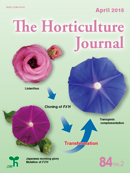Volume 84, Issue 2
Displaying 1-10 of 10 articles from this issue
- |<
- <
- 1
- >
- >|
ORIGINAL ARTICLES
-
Article type: Original Articles
2015 Volume 84 Issue 2 Pages 99-105
Published: 2015
Released on J-STAGE: April 21, 2015
Advance online publication: February 21, 2015Download PDF (1024K) Full view HTML -
Article type: Original Articles
2015 Volume 84 Issue 2 Pages 106-110
Published: 2015
Released on J-STAGE: April 21, 2015
Advance online publication: March 12, 2015Download PDF (838K) Full view HTML -
Article type: Original Articles
2015 Volume 84 Issue 2 Pages 111-121
Published: 2015
Released on J-STAGE: April 21, 2015
Advance online publication: February 21, 2015Download PDF (1069K) Full view HTML -
Article type: Original Articles
2015 Volume 84 Issue 2 Pages 122-130
Published: 2015
Released on J-STAGE: April 21, 2015
Advance online publication: March 11, 2015Download PDF (857K) Full view HTML -
Article type: Original Articles
2015 Volume 84 Issue 2 Pages 131-139
Published: 2015
Released on J-STAGE: April 21, 2015
Advance online publication: March 07, 2015Download PDF (3770K) Full view HTML -
Article type: Original Articles
2015 Volume 84 Issue 2 Pages 140-147
Published: 2015
Released on J-STAGE: April 21, 2015
Advance online publication: March 07, 2015Download PDF (3349K) Full view HTML -
Article type: Original Articles
2015 Volume 84 Issue 2 Pages 148-155
Published: 2015
Released on J-STAGE: April 21, 2015
Advance online publication: March 04, 2015Download PDF (915K) Full view HTML -
Article type: Original Articles
2015 Volume 84 Issue 2 Pages 156-160
Published: 2015
Released on J-STAGE: April 21, 2015
Advance online publication: March 07, 2015Download PDF (597K) Full view HTML -
Article type: Original Articles
2015 Volume 84 Issue 2 Pages 161-171
Published: 2015
Released on J-STAGE: April 21, 2015
Advance online publication: March 14, 2015Download PDF (2598K) Full view HTML -
Article type: Original Articles
2015 Volume 84 Issue 2 Pages 172-177
Published: 2015
Released on J-STAGE: April 21, 2015
Advance online publication: February 21, 2015Download PDF (4366K) Full view HTML
- |<
- <
- 1
- >
- >|
